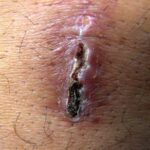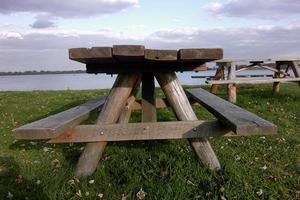Recently, our 12-year-old granddaughter, Aspen, and her 9-year-old sister, Autumn, came to our house for a visit. Aspen had a few mosquito bites on her legs, but I thought little of it, as she loves the outdoors and seldom bothers to protect herself with repellant. Most bites make really bad-looking places on her skin, but they usually heal up with no problem.
That was the case with most of these bites, but one on her left shin only looked worse as the days went by. We had picked the girls up on Wednesday, and by Saturday, in spite of my doing all the things I would normally do for insect bites, and then some, the place on her shin looked downright scary. At my request, she took a picture of it with her cell phone and text-messaged it to her parents. But the picture didn’t look as bad as the bite.
In retrospect, I know we should have taken her to a doctor, but on Saturdays that would be a 50-mile drive from our little backwoods town, plus we had failed, for once, to get a “permission to treat” form and a copy of their insurance card from her parents.
By Sunday morning I was sure she had been bitten by a brown recluse spider, which, needless to say, was an unnerving thought. There was by then an enlarging hole in the middle of the red, inflamed, swollen “bite.” I kept it clean and covered with a bandage. That was necessary, as when the bandage was removed, drainage from the bite ran down her leg. By then the whole leg hurt and she could hardly stand for me to touch it.
We made arrangements to meet her parents that day at the half-way point between their home and ours to return the girls to them. When her parents saw the bite, they immediately started calling around trying to find a nearby walk-in clinic that was open on Sunday and would take their health insurance. They wound up driving two hours to Tulsa, where she was examined at a walk-in clinic.
A few hours later, my son called and said the bite was perhaps not a bite at all, but most likely was a boil caused by MRSA, a potentially deadly staph infection. Methicillin-resistant Staphylococcus aureus had previously been prone to strike primarily hospital patients, but now an even more dangerous form of it, known as community-associated MRSA (CA-MRSA) is striking patients who haven’t been in a hospital, with an unusual number of outbreaks among athletes on sports teams.
Aspen is an athlete, active in softball, basketball, track, swimming, and any other sport available to her. But at this time, during the summer break from school and after the softball season was over, the only place she could think of where she had been, and had shared clothing with other girls, was at church camp. But we will probably never know where she contracted the disease.
When I heard of her diagnosis, I remembered an article in the latest issue of Reader’s Digest, which told about this same infection. For those who are interested in reading the article, it is titled “Deadly Superbugs” and is in the August, 2007 issue.
This article told of Drew, a 16-year-old athlete who felt a little ill on Monday night and told his parents he thought he might be coming down with the flu. Since his temperature was only 99 degrees, his parents assumed he would be all right. By Wednesday, he had a stuffy nose, a cough, and a mild fever, so he stayed home from school. By that afternoon, he could barely breathe, so was rushed to the doctor’s office, where X-rays revealed his lungs were congested. Since he didn’t respond to any medications, he was flown to a major hospital and put on a heart-lung bypass machine. There he was given a 30 percent chance of living, because his lungs were shutting down from extreme infection.
Fortunately, the young man survived, but in just a few weeks his weight had dropped by 40 pounds.
On investigation, it was learned that Drew had developed a skin infection after a scrape during football practice months before. Experts think the infection may have been an undiagnosed bout of CA-MRSA, which can sometimes clear up on its own in mild cases.
The article states that 2.3 million Americans may be carrying the bacteria in their noses without symptoms, according to the Centers for Disease Control and Prevention. These carriers can infect others, or they can suddenly become ill themselves if the bacteria get past the body’s defenses. Any break in the skin’s protective barrier, such as a scratch, a cut, a razor nick, or even nose picking which may injure nasal passages can set the stage for a staph infection.
Having the flu can also weaken the immune system and allow the staph bug to jump from the nose to the lungs. Drew appeared to be battling the flu when this episode started, and the staph-induced pneumonia set in.
This article also included another incident involving Andy, a sixth-grade boy who fell off his bike, banging his hip. He was soon in such excruciating pain that he could barely walk and he had a fever of 104 degrees. It was necessary for doctors to make an eight-inch incision in his hip to drain pus from the MRSA infection that had set up there. Soon he was short of breath, and tests revealed fluid buildup in his chest, a result of the infection having spread to his lungs. The doctor said the infection was eating holes in his lung, and unless it was surgically incised, he would die.
It was unknown how the bacteria had entered Andy’s body, as there was no break in his skin. But he had cracked a bone in his foot two weeks earlier, and doctors say the two injuries may have been contributing factors, as it’s easier for the infection to occur in traumatized tissue.
Since the boy’s father has a history of boils, it’s possible the father may be a carrier of the staph bug, although he had not been tested for it at the time the article was written.
Fortunately, Andy, too, recovered.
But baby Madeline was not so fortunate. She started out with a runny nose and a cough, then suddenly stopped breathing. Paramedics revived her and she was rushed to a hospital, but MRSA had already destroyed one of her lungs and was starting in on the other. All the best efforts of the medical professionals could not save her, and she died after a short time.
Aspen’s doctor said he sees as many as 10 cases a day of this staph infection. I have recently heard that other doctors in our area are seeing more and more of them, and many are mistakenly thought to be a bite in the beginning.
I know all this sounds frightening. Nobody wants anyone they know, and especially those they love, to be afflicted with this terrible disease. But we need to know who the enemy is and how to fight him. What can we do to protect ourselves and our loved ones from CA-MRSA?
Again, this information is taken from the August ’07 issue of Readers Digest, and I highly recommend you try to obtain a copy and read it. If it is no longer available for purchase, perhaps your local library will have a copy on hand.
Doctors recommend the following steps, which I have tried to condense:
Keep your hands clean. Teach your kids to wash their hands frequently and have them carry alcohol-based hand sanitizer for times when they don’t have access to soap and water.
Cover cuts and scrapes. Any wound should be washed with soap and water (and some recommend using alcohol as well) and covered with dry, sterile bandages till it heals. A new dressing should be used daily. Anyone changing bandages should wash or sterilize their hands afterwards. Any pus from an infected wound can contain MRSA and can spread the infection rapidly.
Don’t share personal items. Kids should be told not to share any personal items belonging to other team members or friends. That includes towels, wash cloths, clothing, razors, or anything else of a personal nature. People who appear to be healthy can be carriers of MRSA. Athletes should have clean towels, practice clothing, and uniforms for each wearing. Drew now takes two showers a day, washes his hands at every opportunity, sanitizes his helmet with disinfectant wipes, cleans his locker every day, and always wears freshly laundered uniforms. He has learned to be extremely particular about hygiene.
Sanitize gym clothing and linens. If any family member has a cut, sore, or infection, all bedding, towels, etc. should be washed in hot water with bleach added, and dried in a hot dryer. Athletic gear which cannot be bleached should be washed in hot water with detergent and dried in a hot drier.
Get your flu shots. Since flu is known to weaken the immune system, it is recommended that everyone, and especially the kids, have flu shots, preferably in October or November. Flu shots have been approved for kids over six months old.
Get tested. If you or some member of your family has a skin infection that requires medical treatment, ask the doctor to test for MRSA, so the right antibiotic can be prescribed at the start. With this bacteria (sometimes known as the “flesh-eating bacteria”) it is essential to get the right treatment as soon as possible. CA-MRSA bacteria produce toxins that kill white blood cells–the body’s main infection fighters. It is often difficult and sometimes impossible to find an antibiotic to kill it, so time is of the essence.
There is much more in the article about all the reasons for being tested. Suffice it to say it’s a very important step to take.
Take all your medication. Never stop taking a prescribed round of antibiotics even if the wound heals or if the symptoms of some other condition for which you are taking antibiotics seem to be gone. Bacteria you leave alive today can become tomorrow’s superbugs.
Aspen’s leg wound is still healing, she is no longer having to take pain medication, and we hope and pray she will recover completely with no remissions. But we have learned not to take lightly any apparent bite, or even a case of sniffles, after reading this article.
In addition to the information from the Reader’s Digest, I would like to pass along a bit of advice I have been given by a friend who likes to do things the natural way and who does a lot of research on any illness or condition she hears about. She told of a friend who had the MRSA as a skin infection, and none of the antibiotics, etc. had yet healed it up. This friend had been told to eat yogurt with active cultures or to take acidophilus capsules. She tried it and immediately her visible, at least, infection cleared up.
For that reason, I’m urging my grandchildren, who like yogurt anyway, and any other family members who will, to eat the yogurt (only the kind with ACTIVE cultures) or take the acidophilus capsules daily as a precaution. It might actually help build up a resistance to the MRSA.
While I don’t claim this is authorized medical advice and can’t say it will work for everyone, it should be harmless for anyone with no milk allergies. One could always ask his/her doctor if he/she saw any harm in it. Since these cultures are “good bacteria,” perhaps they are more effective for fighting the “bad bacteria” than some antibiotics.
But I would urge anyone who suspects they or a family member might have this infection to see a doctor first, and use the yogurt or acidophilus as a back-up. In today’s world of bacterial enemies, our bodies need all the help they can get.




